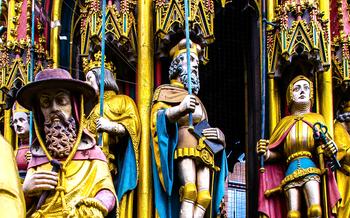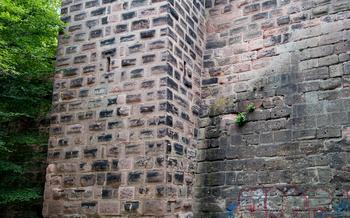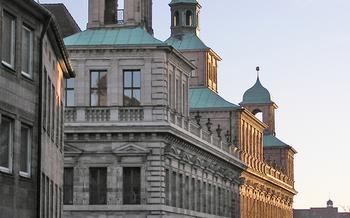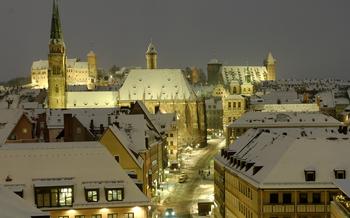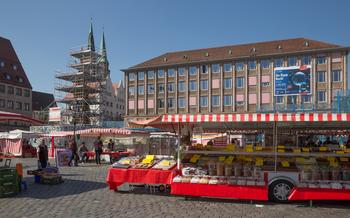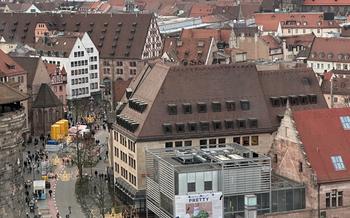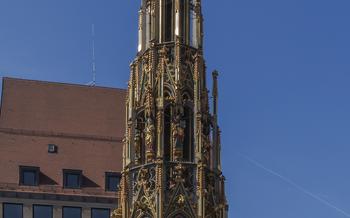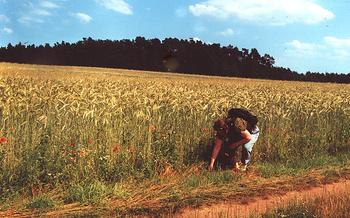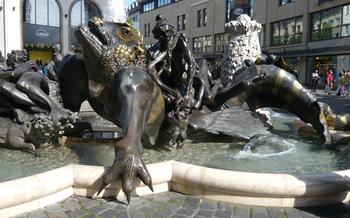
Paradise Fountain (Paradiesbrunnen)
- The Paradise Fountain (Paradiesbrunnen) in Nuremberg
- History and Origin
- Description and Design
- Symbolic Meaning
- Location and Surroundings
- Historical Significance
- Conservation and Restoration
- The Sculptures and Figurines
- The Fountain's Inscriptions
- The Fountain's Colors and Patina
- The Fountain's Water Feature
- The Paradise Fountain as a Tourist Attraction
- Local Legends and Stories
- Events and Festivals
- Accessibility and Facilities
- Tips for Visiting
- The Paradise Fountain in Art and Literature
- Insider Tip: Hidden Detail
The Paradise Fountain (Paradiesbrunnen) in Nuremberg
History and Origin
The Paradise Fountain is the oldest public fountain in Nuremberg, dating back to 139It was originally named after the nearby Frauenkirche, but over time it became known as the Paradise Fountain due to its intricate carvings depicting scenes from the biblical story of Adam and Eve. The fountain was commissioned by the city council to symbolize the city's wealth and power, and it quickly became a beloved landmark among the citizens of Nuremberg.
Description and Design
The Paradise Fountain is a Gothic-style fountain made of red sandstone. It features an octagonal basin with a central column rising from the center. The column is divided into four levels, each adorned with intricate carvings and statues. The lower level features figures of Moses, David, Daniel, and the Virgin Mary, while the upper levels depict scenes from the life of Christ. The fountain is crowned by a spire with a cross, symbolizing the city's Christian heritage.
Symbolic Meaning
The Paradise Fountain is a powerful allegory of the virtues of faith, hope, and love. The figures of Moses, David, Daniel, and the Virgin Mary represent the Old and New Testaments, and their placement on the fountain symbolizes the unity of the Christian faith. The fountain also serves as a reminder of the city's imperial past, as Nuremberg was a free imperial city for centuries. The fountain's intricate carvings and statues are a testament to the city's wealth and power, and they continue to inspire awe and wonder in visitors to this day.
Location and Surroundings
The Paradise Fountain stands proudly in the heart of Nuremberg's Old Town, gracing the bustling Hauptmarkt (Main Market Square). Surrounded by an array of historic buildings, the fountain adds to the charm and ambiance of this vibrant square. One of the most striking features of the fountain's location is its proximity to the Frauenkirche (Church of Our Lady), a magnificent Gothic masterpiece that dominates the skyline. Another nearby attraction is the Schoner Brunnen (Beautiful Fountain), an equally impressive fountain with its own unique history and symbolism. Finally, the Nassauer Haus, a splendid Renaissance-style building, is just a stone's throw away, showcasing the architectural diversity of Nuremberg's Old Town.
Getting to the Paradise Fountain is a breeze. Its central location makes it easily accessible on foot from anywhere in the city center. Alternatively, visitors can take advantage of Nuremberg's efficient public transportation system, with several bus and tram lines stopping within walking distance of the fountain. Even those arriving by train can enjoy a leisurely stroll from the central train station, taking in the sights and sounds of the Old Town along the way.
Historical Significance
The Paradise Fountain stands as a symbol of Nuremberg's imperial past, a testament to the city's independence and wealth during its time as a free imperial city. The fountain embodied the city's pride and power, reflecting its status as a thriving center of trade and commerce.
The fountain's prominent location in the heart of the city, adjacent to the Frauenkirche, further underscores its significance. It became a gathering place for citizens and visitors alike, serving as a focal point for community events and celebrations.
The Paradise Fountain's artistic and architectural value is undeniable. Recognized as a masterpiece of Gothic art and architecture, it showcases intricate carvings and a harmonious design. The figures of Moses, David, Daniel, and the Virgin Mary, each with their unique symbolism, contribute to the fountain's overall narrative and allegorical meaning.
In addition to its historical and artistic significance, the fountain also played a practical role in local culture. It initially served as a source of drinking water for citizens, demonstrating its importance as a vital resource in the community. Later, the fountain evolved into a significant landmark for trade, guiding merchants and visitors to the city's bustling market square.
Conservation and Restoration
The Paradise Fountain holds immense cultural and historical significance, making its preservation a priority for the city of Nuremberg. Over the years, the fountain has undergone several restoration efforts to maintain its original appearance and ensure its longevity. In the 19th and 20th centuries, major renovations were carried out, focusing on repairing structural damage and restoring the fountain's intricate carvings. These efforts aimed to preserve the fountain's authenticity and prevent further deterioration.
Currently, the fountain undergoes regular cleaning and upkeep to maintain its beauty and functionality. The city authorities recognize the importance of preserving this iconic landmark for future generations and actively work to ensure its continued existence as a symbol of Nuremberg's rich heritage.
The Sculptures and Figurines
The Paradise Fountain is adorned with four exquisite sculptures that hold significant religious and symbolic meanings. Standing proudly atop the fountain's central column, these figures represent virtues and biblical narratives that were highly revered in medieval times.
-
Moses and the Ten Commandments: Moses is depicted with a solemn expression, holding a tablet inscribed with the Ten Commandments. This figure symbolizes the law and justice, reminding viewers of the divine authority that governs human conduct.
-
David and Goliath: The mighty warrior David is portrayed standing triumphantly over the defeated giant Goliath. This sculpture represents the triumph of good over evil, emphasizing the power of faith and courage in overcoming adversity.
-
Daniel in the Lion's Den: Daniel, a young man of unwavering faith, is shown standing amidst a pride of lions. This figure symbolizes trust in God's protection, as Daniel remained unharmed despite being thrown into the den of hungry lions.
-
Virgin Mary with the Christ Child: The graceful figure of the Virgin Mary holds the infant Jesus in her arms, representing compassion and love. This sculpture serves as a reminder of the divine love and mercy that guides and protects humanity.
The Fountain's Inscriptions
The Paradise Fountain is adorned with several Latin inscriptions that provide historical context and explanations. These inscriptions are found on the fountain's base and its four levels. They shed light on the fountain's symbolism and purpose and offer insights into the values and beliefs of the time.
The inscription on the fountain's base reads: "ANNO DOMINI MCCCXCVI FACTUM EST HOC OPUS" ("In the year of our Lord 1396, this work was made"). This inscription indicates the year of the fountain's completion and serves as a reminder of its long and storied history.
The inscriptions on the fountain's levels provide explanations of the figures and scenes depicted on each level. For example, the inscription on the first level reads: "HIC EST MOYSES CUM LEGIBUS" ("This is Moses with the laws"). This inscription identifies the figure of Moses and his association with the Ten Commandments.
The inscriptions on the Paradise Fountain are valuable sources of information about the fountain's symbolism and purpose. They help us to understand the religious and cultural context in which the fountain was created and add depth and meaning to our appreciation of this remarkable work of art.
The Fountain's Colors and Patina
The Paradise Fountain is constructed from red sandstone, which gives it a warm and inviting appearance. Over time, the sandstone has developed a patina, a thin layer of oxidized minerals that has created a unique and aged look. This patina enhances the fountain's historical charm and adds to its visual appeal. The colors and textures of the sandstone and patina combine to create a visually stunning work of art that is both timeless and contemporary.
The Fountain's Water Feature
The Paradise Fountain is not merely a decorative piece; it is also a functioning water feature. The basin is continuously filled with fresh water, which provides a sense of tranquility and movement. The gentle flow of water creates a calming atmosphere, inviting visitors to pause and appreciate the beauty of the fountain and its surroundings.
Beyond its aesthetic appeal, the water in the fountain also holds symbolic significance. In many cultures, water is associated with life, purity, and renewal. In the context of the Paradise Fountain, the flowing water represents the spiritual and symbolic significance of the fountain, evoking themes of redemption, rebirth, and the eternal cycle of life.
While the fountain no longer serves as a direct source of drinking water for citizens, it continues to be a vital part of Nuremberg's urban landscape. The sound of the flowing water adds to the charm and ambiance of the Old Town, creating a harmonious blend of history, art, and nature.
The Paradise Fountain as a Tourist Attraction
The Paradise Fountain stands as one of Nuremberg's most iconic landmarks, attracting visitors from around the globe. Its rich history, intricate design, and symbolic meaning captivate the hearts of those who behold it. As a must-see attraction, the fountain offers a glimpse into the city's past while providing a picturesque backdrop for photography enthusiasts. History buffs will delight in exploring the fountain's symbolism and historical significance, while art lovers will appreciate its intricate carvings and Gothic-style architecture. Whether you're a local or a tourist, the Paradise Fountain is an essential stop on any Nuremberg itinerary, beckoning you to immerse yourself in its beauty and cultural significance.
Local Legends and Stories
The Paradise Fountain has inspired numerous local legends and stories over the centuries, adding to its mystique and cultural significance. One of the most popular tales is The Legend of the Golden Ring. According to legend, a young woman once found a golden ring in the fountain's basin. Believing it to be a sign of good luck and fortune, she kept the ring and cherished it for the rest of her life. The story symbolizes the fountain's association with prosperity and the belief that it brings good fortune to those who visit it.
Another captivating tale is The Stolen Cherub. In the early 1900s, one of the cherub statues adorning the fountain was stolen by a group of mischievous students. The theft caused an uproar in the city, and the cherub became a symbol of the community's attachment to the fountain. After a lengthy search, the statue was eventually recovered and returned to its rightful place, much to the delight of the citizens.
Finally, there's the tradition of the Wishing Well. Visitors to the fountain often toss coins into the basin, making a wish as they do so. According to local lore, if the coin lands in the fountain's center, the wish will come true. This tradition adds a touch of magic and whimsy to the fountain and reflects the belief in its ability to grant wishes and bring good fortune.
Events and Festivals
The Paradise Fountain serves as a central gathering place for various events and festivals throughout the year. During the festive season, the fountain is transformed into a magical winter wonderland with twinkling lights and Christmas decorations. The Nuremberg Christmas Market, one of the oldest and most renowned in Germany, envelops the fountain and its surroundings in a warm and enchanting atmosphere. Visitors can stroll through the wooden stalls, savor traditional delicacies, shop for unique handicrafts, and enjoy live music and performances.
In the summer, the Brunnenfest (Fountain Festival) celebrates the fountain's rich history and cultural significance. This annual festival brings the fountain to life with music, performances, and guided tours. Locals and tourists alike gather to witness the fountain's colorful decorations, listen to captivating stories and legends, and immerse themselves in the vibrant atmosphere of the Old Town.
In addition to these major events, the fountain also serves as a backdrop for various public gatherings and performances. From concerts and art exhibitions to historical reenactments and cultural fairs, the fountain's surroundings provide a dynamic and engaging space for community events and celebrations.
Accessibility and Facilities
The Paradise Fountain is designed to be accessible to all visitors, including those with disabilities. Wheelchair ramps and designated viewing areas allow for easy access to the fountain and its intricate details. Public restrooms are conveniently located nearby, and cafes and restaurants in the vicinity offer refreshments and seating for those who need a break from exploring. Guided tours of the fountain and the Old Town are also available, providing insights into the fountain's history, symbolism, and cultural significance.
Tips for Visiting
Planning a visit to the Paradise Fountain is a rewarding experience that offers a glimpse into Nuremberg's rich history and culture. Here are some tips to make the most of your visit:
-
Best Time to Visit: The fountain is accessible year-round and offers a unique experience in every season. However, the best time to visit is during daylight hours, particularly in the morning or late afternoon, when the sunlight illuminates the fountain's intricate details. During the Christmas season, the fountain is decorated with festive lights and ornaments, creating a magical atmosphere.
-
Photography Tips: Capture the fountain's grandeur with a wide-angle lens to encompass its entirety and the surrounding historic buildings. Experiment with different angles and perspectives to create unique shots. For close-up details, use a macro lens to highlight the intricate carvings and sculptures.
-
Exploring the Area: The fountain's central location in the heart of Nuremberg's Old Town makes it an ideal starting point for exploring other attractions. Take advantage of the fountain's proximity to visit the nearby Frauenkirche, Schoner Brunnen, and Nassauer Haus, each offering its own unique charm and historical significance.
The Paradise Fountain in Art and Literature
The Paradise Fountain has served as an inspiration for artists and writers throughout history, contributing to its cultural significance beyond its physical presence. Local artists have immortalized the fountain in their paintings, drawings, and sculptures, capturing its unique beauty and intricate details. These artistic renditions provide a fresh perspective on the fountain and allow viewers to appreciate its significance from a different lens.
In addition, the fountain has found its way into the realm of literature, appearing in historical novels and travelogues. These written accounts often weave the fountain into the narratives, using it as a backdrop for stories or as a symbol of the city's rich history. By featuring the fountain in their works, authors have helped to immortalize its legacy and ensure its place in the cultural fabric of Nuremberg.
The fountain's presence in art and literature has played a vital role in promoting its global recognition. Through these creative expressions, the fountain's beauty and symbolism have reached audiences beyond Nuremberg, sparking curiosity and encouraging people to visit this iconic landmark in person.
Insider Tip: Hidden Detail
Take a closer look at the intricate carvings that adorn the Paradise Fountain, and you'll discover a menagerie of hidden animals and mythical creatures peeking out from among the foliage and gargoyles. These delightful details add a touch of whimsy and charm to the fountain's design, inviting viewers to linger and explore its many hidden treasures. From mischievous monkeys to majestic lions, each creature seems to have its own story to tell, adding an extra layer of depth and intrigue to this iconic landmark.
